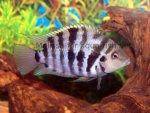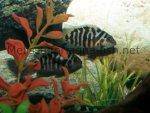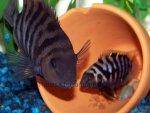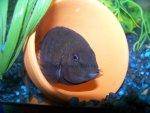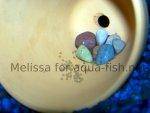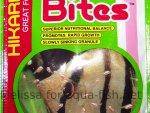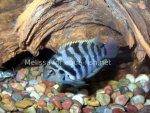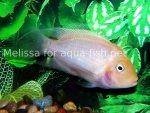The Convict Cichlid - Proper Care, Breeding, Tips & Forum
Quick navigation
Brief Description
This page offers article about raising Convict cichlids, FAQ, pictures and forum devoted to this cichlid species. You're welcome to share your own experiences, this is why you can use a form at the bottom of this page - whether you'd like to ask or share tips, tell us about your Convicts, please! Also visit the following page too: Profile of Convict cichlid which also contains user comments!
Introduction
The Archocentrus nigrofasciatus is a cichlid fish that is nicknamed “convict” or “zebra” both names for its similarity to the black stripes on a British prison uniform. This fish is native to the Central American waters of Guatemala, El Salvador, Costa Rica, Honduras and Panama with temperatures ranging from 69 - 84°F (~ 20 - 29°C). They are not very demanding regarding the conditions of the water as long as you keep a certain amount of consistency. Convicts are omnivorous and they are not picky eaters. This species will eat anything small enough to fit in their mouths including flake and pellet foods, small fish, crustaceans and blood worms. Although they do seem to particularly enjoy frozen beef hearts. Convict males grow to roughly 6 inches (~15 cm), slightly larger than the females. This is an extremely aggressive species that will take on any fish including those twice their size especially in the reproductive phase.
Sexual dimorphism
Convicts are known for their highly reproductive tendencies and it is said that they will spawn absolutely anywhere and everywhere. It is really easy to tell the females apart from the males for this particular species because of their very distinguishing differences. Females are unusually brighter in colour and are more attractive than males. They tend to be smaller and rounder. Females have bright orange splotches on their bellies while their light grey stripes contrast dramatically against their black stripes. These colours become even more distinct when they are ready to spawn. The males tend to be darker grey with black stripes, have pointier pectoral, dorsal and anal fins and are generally larger than the females. Mature males develop a vestigial lump on the head much like the flower horn cichlid. The hump on the head is not useful to the fish in any way and no one really knows why it’s there. Both males and females tend to develop iridescent blues, greens and yellows on their fins when they are comfortable and happy in their environments. All it takes for convicts to be happy and healthy is clean water and a well balanced cichlid diet. Once this is achieved they are ready to spawn.
Breeding
Once a male and a female have bonded to form a monogamous pair they begin reproducing. Convict cichlids become mature enough to reproduce at a very young age. At less than 2 inches (5.08 cm) long and as little as 16 weeks of age a convict can start to spawn. Courtship takes almost no time at all before they find a spot to claim, usually in a cave or under rocks or logs. In captivity a flower pot always seems to do the trick.
I had two pairs of convicts for about a month without spawning. I introduced a flowerpot into the tank and the very next day I saw eggs scattered across the bottom. It's possible it was just a coincidence, however this scenario is very common in general. The new parents were so defensive that I decided to give them some privacy with their eggs by relocating the other pair to a different tank. The reproducing couple still felt the need to hide their young under piles of gravel so the male tore out every plant in the tank while digging his holes.
If you keep a close eye on a pair of convicts you’ll be able to tell they are ready to spawn when the female’s colours deepen as she becomes ready to lay her eggs. The male will stand guard and chase away anyone who dares to come near. One pair of convicts will take over the entire aquarium for the sake of brood care. You’ll notice all the other fish cowering on one side of the aquarium as convicts are excellent parents, and extremely protective. They will hide their young if they think their babies are in danger. This is extremely impressive parenting for a fish. Once the eggs are laid and fertilized the female will take position above them and continuously fan them with her fins. It takes less than a week for the eggs to hatch and then about 3 more days for the fry to absorb their yolk sacs. This is when they become free swimmers and are ready to begin eating fry food. Fry foods can consist of newly hatched brine shrimp, live microworms, ground fish flakes or food can be bought in the form of powder. Be sure to feed fry a nutritious diet with plenty of protein because the foods they eat at this stage will influence their development into quality cichlids later.
The convict cichlid can also be found in a leucistic strain known as the pink convict, white convict or gold convict. Leucism is a condition characterized by reduced pigmentation in animals. Unlike albinism, it is caused by a reduction in all types of skin pigment, not just melanin. This strain of convict is not as easy to breed as the common zebra-striped version but they are reproduced for the sake of the aquarist industry and their breeding habits are the same. The females are whitish-pink with red splotches on their bellies and the males are just plain whitish-pink.
Convict fish are interesting to have because of their active and reproductive natures. Because of their adaptable nature they are relatively easy fish to keep. You’ll enjoy watching their aggressive behavior as well as their instinctive parenting skills. Overall, convicts are great fish for all aquarists whether they are experienced or just starting out.
Questions and answers
Due to merging aqua-fish.net/answers with related articles we moved the following answer here on March 25th 2011. You're welcome to submit your own questions too, use a form at the bottom of this page for this purpose, please!
-
How do you know when convict cichlids are ready to breed?
Answer: When convicts are ready to breed the female will colour up, her belly colour will intensify and the pair will do a mating dance which involves shaking their heads at one another.





